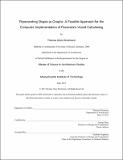| dc.contributor.advisor | George Stiny. | en_US |
| dc.contributor.author | Wortmann, Thomas Alois | en_US |
| dc.contributor.other | Massachusetts Institute of Technology. Department of Architecture. | en_US |
| dc.date.accessioned | 2013-11-18T17:34:45Z | |
| dc.date.available | 2013-11-18T17:34:45Z | |
| dc.date.copyright | 2013 | en_US |
| dc.date.issued | 2013 | en_US |
| dc.identifier.uri | http://hdl.handle.net/1721.1/82166 | |
| dc.description | Thesis (S.M. in Architecture Studies)--Massachusetts Institute of Technology, Dept. of Architecture, 2013. | en_US |
| dc.description | This electronic version was submitted by the student author. The certified thesis is available in the Institute Archives and Special Collections. | en_US |
| dc.description | Cataloged from student-submitted PDF version of thesis. | en_US |
| dc.description | Includes bibliographical references (p. 62-66). | en_US |
| dc.description.abstract | Computational design tools in architecture currently fall into two broad categories: Tools for representation and tools for generative design, including scripting. However, both categories address only relatively methodical aspects of designing, and do little to support the design freedom and serendipitous creativity that, for example, is afforded by iterative sketching. Calculating with visual rules provides an explicit notation for such artistic processes of seeing and drawing. Shape grammars have validated this approach by formalizing many existing designs and styles as visual rule-sets. In this way, visual rules store and transfer design knowledge. Visual calculating in a more general sense supports creativity by allowing a designer to apply any rule she wants, and to capriciously see and re-see the design. In contrast to other explicit design methodologies, visual calculating defines a decomposition into parts only after the design is calculated, thus allowing formalization without impeding design freedom. Located at the intersection between design and computation, the computer implementation of visual calculating presents an opportunity for more designerly computational design tools. Since parametric visual calculating affords the largest set of design possibilities, the computer implementation of parametric visual calculating will allow flexible, rule-based design tools that intelligently combine design freedom with computational processing power. In order to compute with shapes, a symbolic representation for shapes is necessary. This thesis examines several symbolic representations for shapes, including graphs. Especially close attention is given to graph-based representations, since graphs are well suited to represent parametric shapes. Based on this analysis, this thesis proposes a new graph for parametric shapes that is clearer, more compact and closer the original formulation of visual calculating than existing approaches, while also strongly supporting design freedom. The thesis provides algorithms and heuristics to construct this "inverted" graph, for connected and unconnected shapes. | en_US |
| dc.description.statementofresponsibility | by Thomas Alois Wortmann. | en_US |
| dc.format.extent | 66 p. | en_US |
| dc.language.iso | eng | en_US |
| dc.publisher | Massachusetts Institute of Technology | en_US |
| dc.rights | M.I.T. theses are protected by
copyright. They may be viewed from this source for any purpose, but
reproduction or distribution in any format is prohibited without written
permission. See provided URL for inquiries about permission. | en_US |
| dc.rights.uri | http://dspace.mit.edu/handle/1721.1/7582 | en_US |
| dc.subject | Architecture. | en_US |
| dc.title | Representing shapes as graphs : a feasible approach for the computer implementation of parametric visual calculating | en_US |
| dc.title.alternative | Feasible approach for the computer implementation of parametric visual calculating | en_US |
| dc.type | Thesis | en_US |
| dc.description.degree | S.M.in Architecture Studies | en_US |
| dc.contributor.department | Massachusetts Institute of Technology. Department of Architecture | |
| dc.identifier.oclc | 861229751 | en_US |
